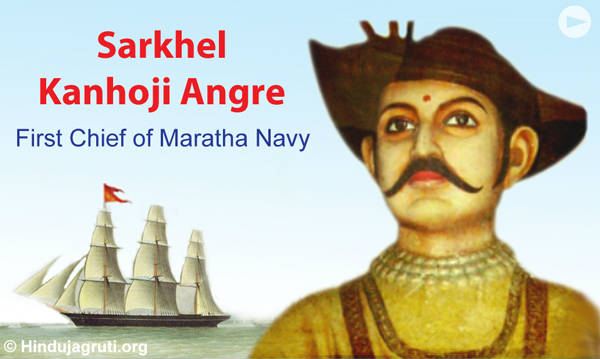
Index
- Introduction
- Birth and early life
- Kanhoji becomes the Admiral of Maratha Navy
- Naval expeditions and achievements of Kanhoji Angre
- Major battles under command of Kanhoji Angre
- Fearless and Courageous Kanhoji Angre
- Specialty of mighty Maratha Navy under the command of Kanhoji Angre
- Legacy
- Kanhoji can’t be classified as a Pirate : Legal Scholar William Hall
- Bases
Introduction
Kanhoji Angre (1667–1729), was the first notable chief of the Maratha Navy and popularly known as “Samudratla Shivaji” (Shivaji of the seas).
Kanhoji Angre occupies a unique position in the history of Bharat and in the annals of Arabian sea history. For four decades a terror to the maritime powers of the western coast, he led his sailors from victory to victory and raised the naval prestige of Maharashtra to an unprecedented height. Today largely forgotten, Angria founded a dynasty in the late 1690s that became the main obstacle to the rise of the English East India Company (EIC) as a hegemonic power in the Bombay region. The Company tried to suppress the maritime depredations of the powerful Angrias for more than fifty years, yet to no avail.
The Marathas were said to be “the first and perhaps the only to employ a navy; indeed, as the saying still goes that Shivaji Maharaj carried the capital of his empire on the high seas.
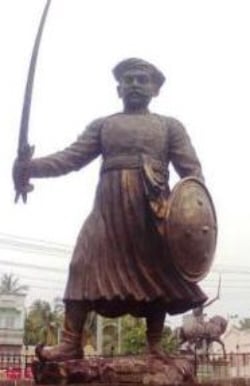
Kanhoji Angre’s name struck the terror in the hearts of all the European Trading Companies which were active in India in the 17th and 18th centuries. The fishermen community on the western coast who knew the sea-coast like the palms of their hands and who were born seamen provided excellent material for the Maratha navy.
Angria stands as a prominent figure that fought successfully against three European and several indigenous powers for over half a century. As a result Angria has become a defender of indigenous sovereignty and been adopted as an early figure of resistance to colonial incursion.
Birth and early life
Kanhoji Born in the village HARNE in Ratnagiri district of Konkan in the year of 1669. The Angrian whose family name is Sankhpal hails from a tiny village, Angarwadi, in the Mawal hills, six miles from Poona. They were guardians of small state named ‘ Vir Rana Sank’ so they became Sankapal.Tukoji, his father took service under the Great Shivaji around 1658 and distinguished himself in several actions. He was rewarded with a command of 200 and posted at ‘Suvarnadurg’ an important naval post which occupied a menacing position hardly twenty miles south of the Sidhi’s frontier. Here Kanhoji first opened his eyes and passed his childhood. Here he watched Maratha ships making out for the open sea and falling upon the enemy’s fleet and here he received the practical training of seamanship from the uncouth but faithful Koli sailors.
Kanhoji becomes the Admiral of Maratha Navy
Maritime activities in erstwhile Indian civilisations also had witnessed hightened military seafaring during Shivaji Maharaj’s times. The Maratha navy was a dreaded force. Shivaji Maharaj had almost 200 fighting ships of various sizes. But then years after Chatrapati Shivaji’s death the navy had shriveled. His son Chatrapati Sambhaji carried on his father’s mission, valiantly crusading the Mughals on land and the Portuguese at sea. After Chatrapati Sambhaji’s death in 1690 it was left to Kanhoji Angre an admiral of outstanding ability who took over the Maratha fleet in 1699 to revive Maratha sea power. By dint of valour and indefatigable effort, Kanhoji succeeded Sidhoji Gujar in the entire command of the Maratha navy, making Kolaba his headquarters. Angre also had to master the dispute in the naval power of his rivals along the west coast of India for the next forty years. When Kanhoji Angre took over, he had many foes to contend with. These were the English based at Bombay, Portuguese at Goa, Siddis at Janjira, Dutch at Vengurla and the Sawants of Wadi. Of these the first four were pretty formidable, but under Kanhoji Angre’s intimidating presence, it was the English who suffered the most at his hands.
Kanhoji’s task was not an easy one. The Central Maratha authority had disappeared; the Konkan province had been overrun and devastated by the Mughals. There were no allies to help, no resources to rely upon and no reinforcements to be expected. On the other hand, in the absence of human allies, his sea-girt castles and their geographical situation in far-away corner afforded Kanhoji excellent protection and from here he sailed forth to attack enemy ships and prey upon their merchantmen. By 1700, Kanhoji is mentioned in foreign records as one of ” the most daring pirates” that infested the Malabar coast and made commerce hazardous.
Naval expeditions and achievements of Kanhoji Angre
The career of Angre was on long series of naval exploits and achievements, rare in the annals of the Indian maritime activity.
It is said that while leading a forlorn cause he had actually been captured by the siddis, but prison walls were no insuperable barrier to him and before long he swam back to the beleaguered castle to lead his comrade once again to a bold assault.
The bravery of Angre was so great that it had caught the vessel carrying the wife of British Governor of Karwar Harvey from Mumbai to Karwar, just two miles from Mumbai. It is worth noting that the vessel was escorted by English Battleships. Maratha battleships made them to run away. The terror of Angre was so great that the two other battleships which were in Mumbai Port did not move out at all. Angre gave safe passage to the wife of Harvey after taking large ransom for her release. .
To get a right perspective of Angrian’s maritime activities, they must be viewed as a part of general struggle of the Maratha nation against the invader’s conquest of their homeland. A Tripartite coalition consisting of the Sidhis, the Mughals and the Portuguese strove in a combined effort to put an end to the Maratha naval power. In the naval action that ensued, Kanhoji emerged victorious and annexed Sagargad. He also extracted revenue from many Principalities along the Konkan coast, like Kolaba, Khanderi, Chaul, etc.
Kanhoji Angre developed dockyard facilities for building his vessels, mounting guns and preparing them for sea. His armada then consisted of 10 grabs and 50 gallivats. Some of the grabs were as big as 400 tons and the gallivats were 120 tons.
By the begining of the 18th century Admiral Kanhoji Angre was in possession of the entire coast from Savantwadi to Bombay. There was hardly a creek,coce,harbour or estuary where he had not established fortifications, such as a fortress or a citadel with navigational facilities. Any voyaging within the Maratha territorial waters was to pay a levy called ‘Chouth’, thus showing Angre’s supermacy in those areas.
In 1717, Kanhoji seized a British ship, the SUCCESS. The British avenged this act by an attack on Vijaydurg, Kanhoji’s main naval base; the attack was unsuccessful.
Major Battles under the command of Kanhoji Angre
Angre was and could afford to be aggressive in the extension of Maratha control over their littoral because the EIC was relatively weak. Bombay, Downing remembered, “was unwalled, and no Grabs or Frigates to protect any thing but the Fishery; except a small Munchew.” It would remain so until December 1715 with the arrival of Governor Charles Boone. Under his authority the Company built 25 vessels within a year, carrying from five to thirty-two guns each, at the cost of £51,700. Now with offensive and defensive capabilities established, an attempt could be made to bring Angria, the upstart Maratha power, to the Company’s terms and become once again the undisputed power over the seas.
The first target was on the island of Kenerey situated at the mouth of Bombay harbor. This had been under Angria’s jurisdiction for the past four years when Emperor Shahu transferred its administration over to the admiral. Two frigates, the Fame and the Britannia were sent with a company of sepoys to attack from land and sea the fortress of Vingorola. They were joined by another frigate, the Revenge and a dozen or so gallivats (small oared twin-masted sailing vessels) to land the troops. Biddulph claims the force returned after unsuccessfully bombarding the fort and being unable to even land the troops for the main assault. The expedition’s leader was blamed for the failure, accused of being a coward, and dismissed from service. Later the same year another force was assembled of over twenty vessels and 2500 European soldiers and 1500 sepoys and topasses. The target was Kanhoji’s headquarters: the fortress of Geriah. This undertaking too proved a failure. The only result was to declare the castle impregnable at the cost of two hundred men killed and three hundred “dangerously wounded.”
Next year the British made an attempt to dislodge the Marathas from their naval base at Khanderi, but again without success. Another force was assembled of over twenty vessels and 2500 European soldiers and 1500 sepoys and topasses. The target was Kanhoji’s headquarters: the fortress of Geriah. This undertaking too proved a failure. The only result was to declare the castle impregnable at the cost of two hundred men killed and three hundred “dangerously wounded.”
In 1720, the British lost their vessel CHARLOTTE which was seized by Kanhoji and taken as prize.1721 saw the most ambitious attack yet: a joint operation with the Portuguese starting in November to take the island and fortress of Kolaba. This time the Royal Navy was brought in under the command of Commodore Matthews and thereafter no non-military Company servants led military expeditions. The Portuguese were to march overland a short distance from their own territory in Chaul with 2,500 land forces while the EIC were going to supply a similar force with the addition of five ships, on top of the Royal Navy, to bombard the fortress from the water and land artillery on shore. When victorious, the Portuguese were to receive Kolaba and the EIC Geriah.Both parties agreed to be full allies and not to enter into separate peace with the enemy. Commanding on the Portuguese side was the Viceroy of Goa himself, Don Antonio de Castro and the General of the North. Kanhoji, having learned of the planned attack, had earlier been able to secure the assistance of 25,000 of Shahu’s troops, which were on their way from the ghats. Marathas came victoriously in this war. Again and again it was proved beyond doubt that the Maratha naval bases were impregnable.
Fearless and Courageous Kanhoji Angre
Within a few years of his rise to power Kanhoji had established the Marathas as a sovereign power over sea and land in contrast to the traditional role of Indian power, as land-based only. The Company for its part had spent the better part of the last century establishing its dominance in the region. The Portuguese, though present were a diminished power. The Dutch too were on their way out, finding it more profitable to concentrate on their holdings in the Moluccas. The Mughals and the EIC had come to an accommodation in the region by reciprocally recognizing each other’s dominance and jurisdiction on land and sea respectively. As a result this allowed the EIC to control regional maritime trade and shipping charges as they saw fit. The Marathas, by claiming control over the same section of coast, challenged Bombay’s recently established power and disrupted the shipping of the Company to the effect of 70,000 rupees out of Surat alone in 1707. The response from the EIC was quick and certain. They sent an emissary to Kanhoji in 1703 to tell him that “he cant be permitted searching, molesting or seizing any boates, groabs or other vessels, from what port, harbour, place of what nation soever they may be, bringing provisions, timber or merchandize to Bombay…without breach of that friendship the English nation has always had with Raja Sevajee and all his Captains in subordination to him.”
Kanhoji replied by asserting the sovereignty of the Maratha state over the rights of the Company, making it clear that the EIC was operating in India on Marathas terms, not their own. Angria informed Bombay that they, “The Savajees had done many services for the English that never kept their word with him; they had peace with the Portuguese and every one of their ports free to them. The Savajees, had been at war with the Mughals for over forty years and they would continue to seize what boates or other vessel belonging either to the Mogulls vessels from any of his forts or Mallabarr, excepting such as had Conjee Angras passports; the English being at liberty acting as they please.” Angre continued to search out vessels that failed to purchase his pass and the English continued to consider this behaviour piratical. An assessment of Angrian piratical practices can only properly be seen if Kanhoji is placed within the larger political framework of which he was an integral part.
Specialty of mighty Maratha Navy under the command of Kanhoji Angre
The expeditions by English, Dutch and Portuguese demonstrated the fallacy of trying to bring Angria to terms on land. On water the Company had not fared much better because though the Company’s ships were superior technologically and militarily, they could not out-maneuver Angria’s small, lightweight, and faster vessels. Furthermore, as in all cases when the British tried to suppress another force on the water, their large ships could not pursue the lighter vessels into the shoals or shallow estuaries. The Marathas for their part could not afford to wage open warfare with the English either as it probably would have resulted in the English joining forces with the Mughals, with whom the Marathas were already in active hostilities. Even if this did not occur, opening another front was not in Maratha’s best interests. Allowing Kanhoji to fight the Company and sending reinforcements to his aid when necessary was a more economical strategy that more-or-less supported the political status quo.
Legacy
Kanhoji Angre died on 4 July 1729, having never lost a battle against the English. Neither had the Company ever seized any of his vessels at sea. Angria successfully extended Maratha sovereignty over the seas against not only the English company, but also the Dutch, and the Portuguese. Thus Kanhoji Angre had emerged as a master of the Arabian Sea from Surat to south Konkan.
Kanhoji is also credited with the foresight that a Blue Water Navy’s role is to keep the enemy engaged away from the shores of the land. At the height of power, Kanhoji’s commanded hundreds of warships and the British Navy could do little to combat the Maratha Navy
It is said that “Had he been in England, like Drake, he would have been knighted and lionised as a national hero, but in India he died merely as an independent ruler who never permitted any foreign ruler to filch even a part of his precious little dominion”
During the initial two decades of 18th Century, the navy of Angre had defeated the English and Portuguese Naval fleets again and again. It had defeated the armies of both on land too. Hence the name of Angre is engraved permanently in the naval history of the world.
The Samadhis (mausoleum) of Kanhoji and his descendants are near Alibag.
Kanhoji cannot be classified as a pirate : legal scholar William Hall
Kanhoji Angre stands alone in the list of early freedom fighter of Bharat as the one person who stood undefeated and inflicted many casualties on colonial powers. However, the English and other shipping powers who were heckled by Angre claimed that he was a pirate, forgetting that he was the appointed admiral of the Maratha Navy.
As an agent of the Maratha state, Kanhoji cannot be classified as a pirate according to legal scholar William Hall because, A pirate either belongs to no state or organised political society, or by the nature of his act he has shown his intention and his power to reject the authority of that to which he is properly subject. So long as acts of violence are done under the authority of the state, or in such way as not to involve its suppression, the state is responsible, and it alone exercises jurisdiction.
Bases
1] In 1698, Angre located his first base at the Maratha fort of Vijayadurg (‘Victory Fort’) (formerly Gheriah) located about 425km from Mumbai. The fort which was originally built by Maratha ruler, Shivaji is located on the coast, and has an entrance hollowed out in it to accommodate entry of a vessel from the sea.
2] Angre created a base on the fortified islands of Khanderi and Underi off the coast of Mumbai, and attempted to levy a tax on every merchant vessel entering the harbor.
3] Angre established a township called Alibag towards the end of the seventeenth century. The main village at that time, was today’s Ramnath. Kanhoji even issued his own currency in the form of a silver coin called the Alibagi rupaiya.
4] Angre even established a base in the Andaman Islands, and is credited with attaching those islands to India.

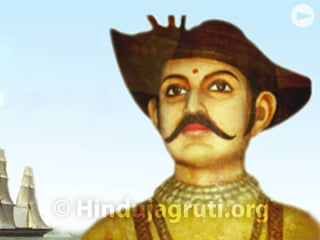
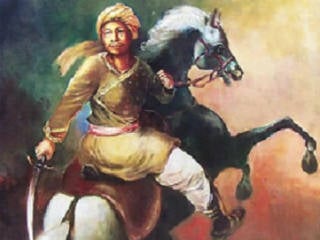 Lachit Borphukan : A great 'unknown' son of Sanatan Dharma
Lachit Borphukan : A great 'unknown' son of Sanatan Dharma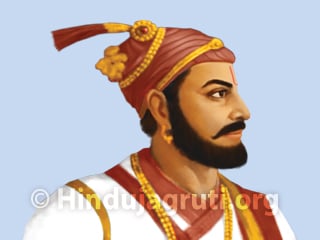 Dharmaveer Sambhaji Maharaj
Dharmaveer Sambhaji Maharaj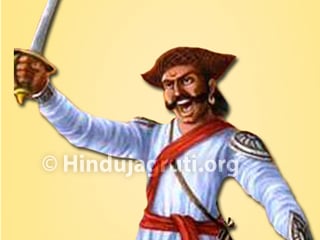 Tanaji Malusare : The conqueror of Sinhagad (the Lion’s Fort)
Tanaji Malusare : The conqueror of Sinhagad (the Lion’s Fort)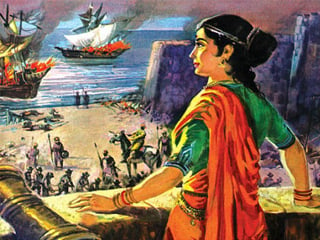 Abbakka Rani : The Warrior Queen who defeated the Portuguese
Abbakka Rani : The Warrior Queen who defeated the Portuguese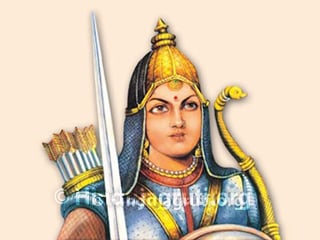 Great Hindu Warrior Queen : Rani Durgavati of Gondwana
Great Hindu Warrior Queen : Rani Durgavati of Gondwana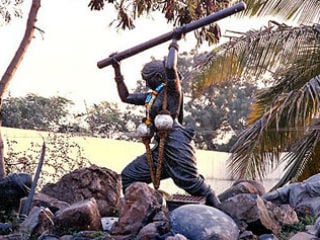 Brave Woman : Onake Obavva
Brave Woman : Onake Obavva